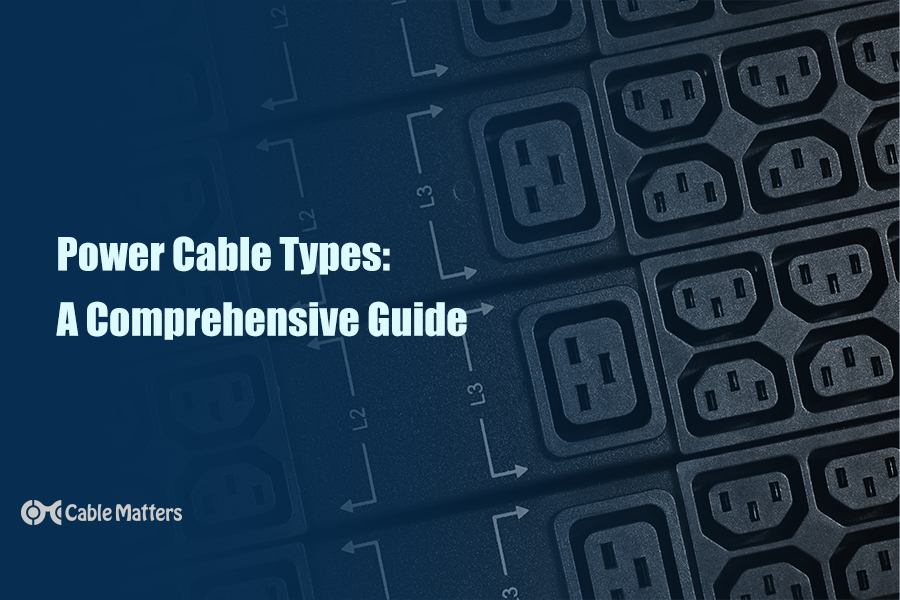
The modern world runs on electricity, which means it runs on power cables. From the three-pronged, grounded kettle leads of the UK, to the unique angled design of Australian plugs, and everything in between, there is a range of power cables all over the world, and plenty of variance within each standard, too.
There’s a little less variance at the other end of the cable, as the world slowly transitions towards USB-C power for many modern electronics. Until that happens universally, though, there are still a lot of different-sized barrel power cables, legacy lightning connectors, older USB standards, and power over Ethernet connectors in some larger-scale networks.
Most of the time the power cable you receive with a device or electronic system is all you need to get it powered up and working, but if you ever feel the need to change it out, it fails and you need a replacement, or you want to make sure you have the most safe and secure power cable type for the job, you need to know what is the right power cable for the job. That’s exactly what this guide is designed to do.
We’re going to look over the core principles of modern power cables and what makes some better than others; the difference between certain power cable standards and what certain ratings mean; the importance of grounding and whether you need it; the different physical shapes and sizes of certain power cables and what benefits they confer; the different power cables used for computers, and the difference between them and networking power cables, and details on how to pick the right power cable for your needs.
It’s a big article with a lot of ground to cover, but when we’re done, you’ll be a power cable-type expert. Let’s get going.
Understanding Power Cable Basics
The humble power cable might seem more straightforward than the various types of data cables used for transferring files, streaming video and audio, and networking systems together. However, with the myriad of different power cables around the world, there’s a lot between them, and a lot to learn if you want to understand different power cable types.
Desktop computers, space heaters, air-conditioning units, televisions, large monitors, and some kitchen appliances need a standard power cord, otherwise known as a mains cable or kettle lead. That’s very different from the USB-C cable you use to charge your phone, which is different again from the range of barrel connectors used to power your smaller gadgets and electronics. That’s different again from the Power Over Ethernet cable that runs your security cameras and other IoT devices.
Every one of those that plugs straight into a wall socket will be different depending on where you are in the world, too. While the USA might use Type-A and Type-B power cables, the rest of the world uses something different. The UK has its own special Type G plugs, while most of the rest of Europe and South America use a combination of Type C, E, and F plugs.
It’s a complicated mess; no wonder international adapters look like Swiss cheese with all the different holes in them. However, you can divide these power cables into three distinct groups: Polarized, non-polarized, and three-prong (grounded). Polarized and non-polarized power cables have just two prongs on the power plug that goes into the wall, but polarized power cables have a shorter power/live prong alongside a longer one that’s connected to the white neutral wire. Some polarized plugs will also have a rounded end to the prong to make it clear which is which.
In non-polarized designs, it’s not obvious which of the two prongs is the live wire, while in three-prong designs, you’ll have a third prong that’s connected to the ground wire.
So when it comes to buying new power cables for your various electronics, it’s important you choose the right one. It has to physically fit the device, and wall socket you want to plug them into. It also needs to match the power needs of your device, including its voltage and current ratings. You also need to make sure that the cable meets or exceeds local, national (and even international) safety standard certifications, to ensure that the power cable won’t break your device at best, or burn down your house at worst.
We’ll dig into specific standards shortly, but for now, just know that the two important organizations to follow are the International Electrotechnical Commission (IEC) and the National Electrical Manufacturers Association (NEMA).
NEMA 1-15 vs NEMA 5-15
NEMA is an organization made up of hundreds of companies that utilize, manufacture, and distribute products that utilize electricity. It’s published thousands of power-related standards over the years, many of which are now mainstays for powering products produced and sold within the United States. These can be broadly split into grounded and ungrounded types, though it has also developed plugs for various voltages.
The most common outlet and plug connections in the United States are the NEMA 1-15 and NEMA 5-15 connections. The 1-15P 125V plug is an antiquated, but common plug design, especially with older devices. It has two parallel flat blades that measure ¼-inches wide, 0.06-inches thick, 5/8-inches long, and spaced 1/2-inches apart. Polarized versions feature a longer neutral prong on the plug, with a deeper grounded port on the 1-15R socket type. They support 15 Amps (Hence the 15 in their name) but are slowly being phased out due to a lack of grounding.
The 1-15R socket type can be found in many older buildings but has been banned in new construction since the 1970s. However, if you find yourself with a modern polarized 1-15P or grounded plug that won’t fit into a classic 1-15R socket, you can use a cheater plug adapter to convert one power cable type to another.
Another popular NEMA standard is NEMA 5-15P plugs, and their 5-15R socket. These are a three-prong design, featuring a neutral white wire, and ground blade, though the ground is rounded, whereas the others are more blade-like. The 5-15P plug design also supports 125V and 15 amps and formed the basis for the IECs 60906-2 standard for other international, grounded plug designs.
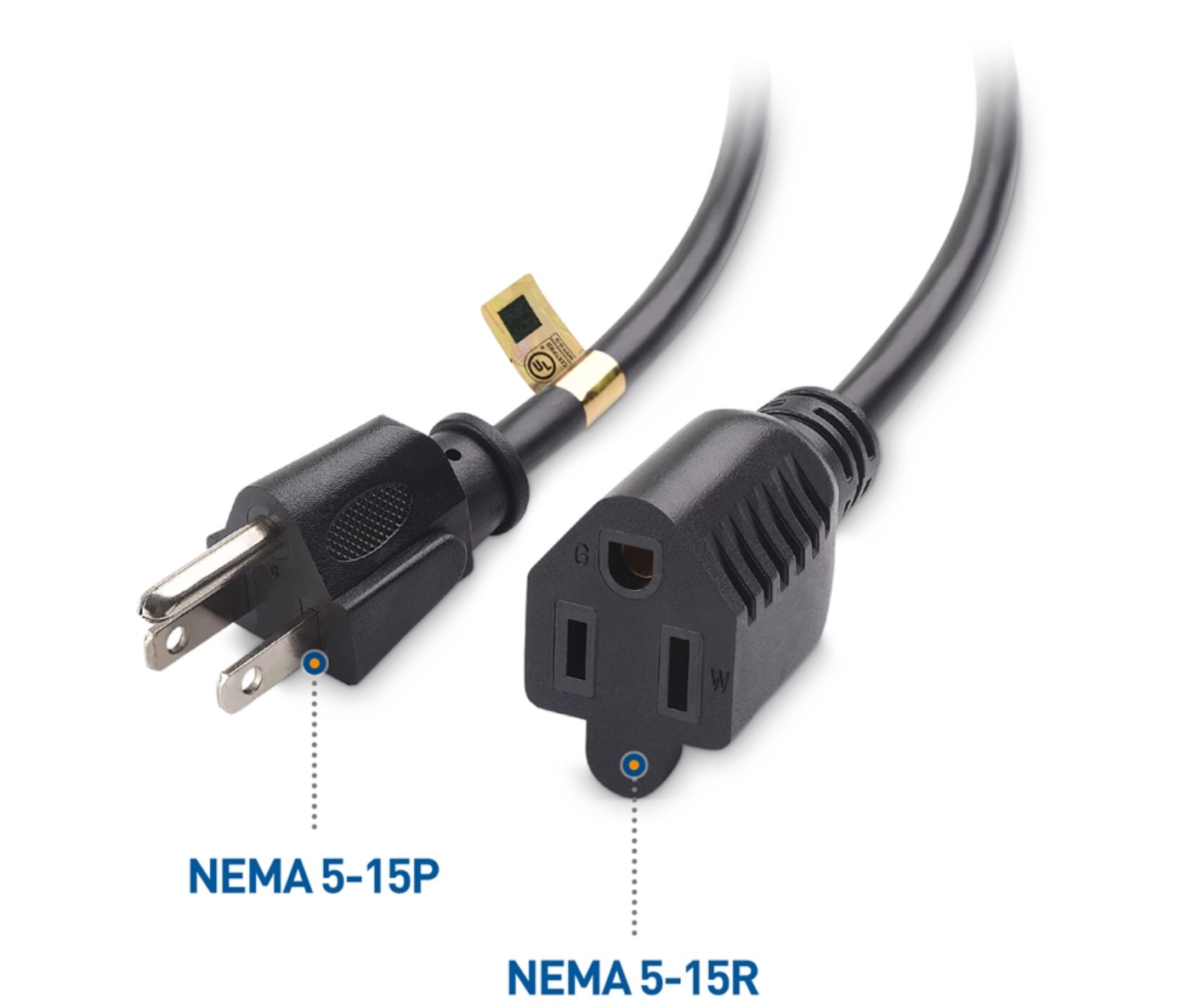
IEC C13/C14 Cables
The IEC is an international organization that provides electrical safety and technological standards for over 170 countries all over the globe. The standards that the IEC produces have unified the electrical world, providing a technical framework that countries can conform to, promoting safety, reliability, and efficiency.
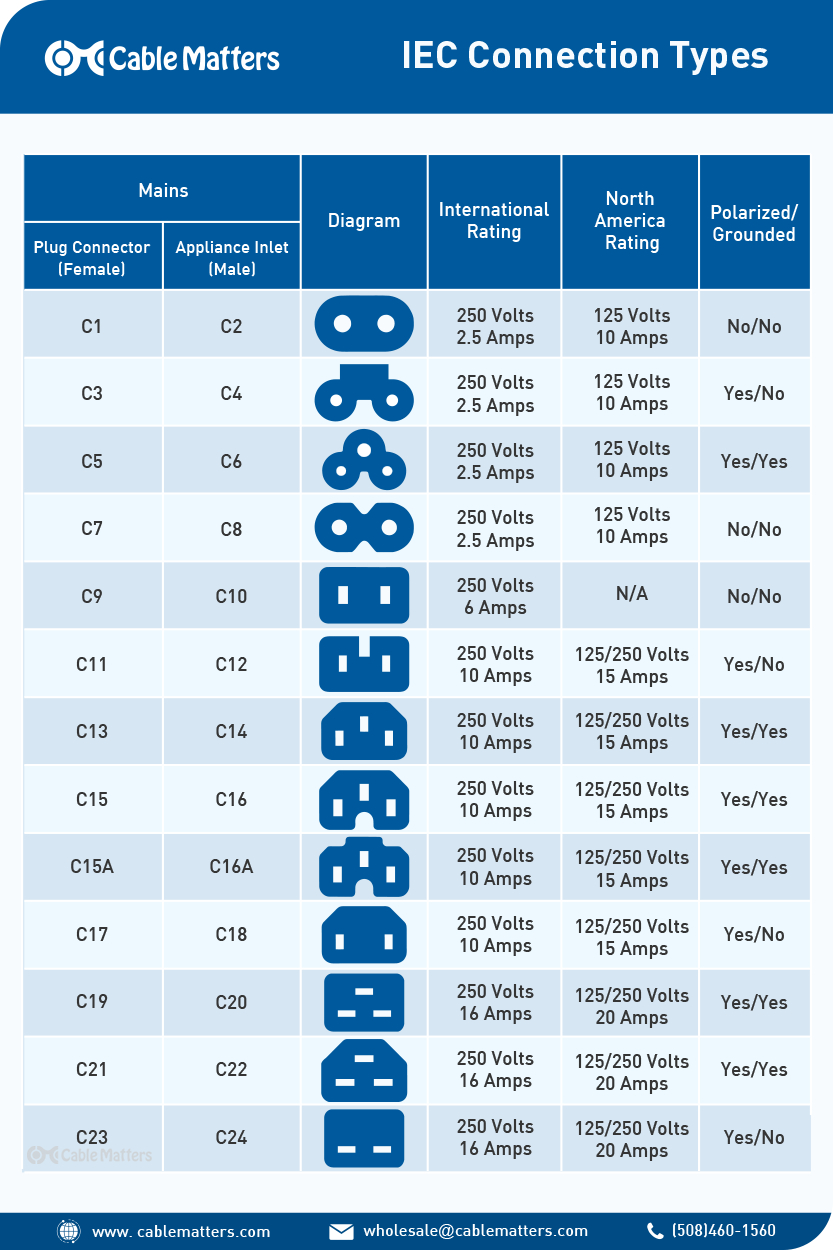
Another common power cable type is the IEC C13 design. This is the standard kettle lead power cord with female receptacles for three metal prongs. You’ll find these used to power a wide range of appliances with detachable power cables like desktop computers, medical equipment office devices, and some laptop chargers.
The IEC C14 standard is the male equivalent of this cable, with the three metal prongs for insertion into the C13 design. You’ll find these kinds of plugs on C13 compatible devices, though they can also be present on power extension leads where you connect a C13 and C14 power cable together for greater range.
These cables support up to 10 Amps of current and 240V. They feature a ground wire as well as polarized pins, making these a very safe way to power a wide range of devices in many different countries. Ironically, despite its “Kettle lead” colloquial name, in countries with 120V, the C15/C16 design must be used for actual kettles, since they support a higher 120-degree temperature rating.
An advantage of using this type of cables is that they are distinctly separate and detachable. This makes it easy and cheaper to replace the cable or plug if it’s damaged, whereas devices with hardwired power cables might require rewiring or entire device replacement in the same situation.
Figure-8 (IEC C7) vs Mickey Mouse/Cloverleaf (IEC C5)
With smaller electronic devices, larger kettle leads aren’t appropriate, so smaller, barrel connectors are used instead. One common type is the IEC C7 design, also known as a “Figure-8” or “infinity” connector. It’s a two-prong power cord often used for DVD players, A/V equipment, home radios, and similar devices.
It’s not polarized, nor is it grounded, and typically ends in a two-prong power plug. It’s rated to handle up to 2.5 amps of current and 125 volts.
Another popular type of smaller power connector is the C5 design, otherwise known as the “Mickey Mouse,” or “Cloverleaf” power connector. This is more often used in switched-mode power supply units, like laptop chargers. It has a three-pronged connector at one end, and a three-pronged plug on the other.
It is grounded and polarized, so offers much greater safety measures than the C7 design. It’s rated to handle 240 volts and 2.5 amps of current.
These connectors are distinct enough that they are not interchangeable, despite their similar size and capabilities.
Power Cables for PCs, Monitors, and Peripherals
Most often you’ll use simple kettle leads (IEC C13) to power desktop computers and most monitors. However, many modern laptops can also be powered by high-power USB-C cables, like Thunderbolt 4 and USB4 connections, which can deliver up to 100W of power for fast charging or powering larger devices. In the case of displays, too, these cables can be used to deliver power to a laptop, although the display itself will still require a traditional power cable.
Internally, desktop computers have power supplies that have a number of different power cable types. They include a large 24-pin power connector for the motherboard, as well as one or more 4 or 8-pin power cables to deliver power to the processor. Some motherboards even require an additional 8-pin PCI Express power connector.
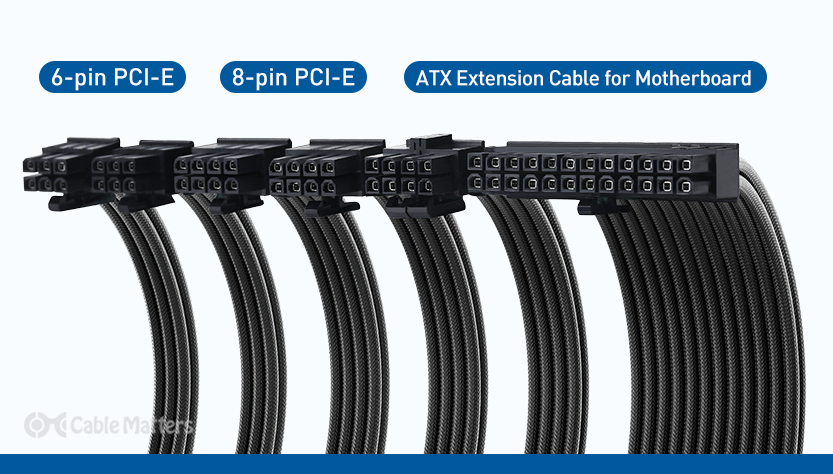
Graphics cards can take one, two, or three PCI Express 8-pin connectors, while some can utilize Nvidia’s bespoke 12-pin and 16-pin power cables, though these can also be converted using adapters from traditional PCI Express power cables. SATA drives, like hard drives and older SSDs, can also leverage an L-shaped connector for power.
External peripherals like mice, keyboards, headphones, and webcams, almost exclusively use USB connections for power, and most often legacy USB-A designs. Some more modern solutions may offer USB-C connectivity, but most ship with pre-attached USB-A cables. Those that have detachable cables may allow for replacement with a USB-C design if that’s more convenient.
Networking Power Cables
For delivering power at longer distances, particularly to IOT and networked devices that would already require a wired Ethernet connection, a popular solution is Power over Ethernet or PoE. These types of connections allow for electric power to be transmitted along the same network cable that’s used to send data back and forth. Common devices that utilize this include security cameras, wireless access points, and VoIP phones.
Like standard Ethernet cables, PoE cables are available in a range of types and categories, including much older Cat 5e PoE cables, and much more modern Cat 8 PoE cables. The original IEEE 802.3af-2003 specification for power over Ethernet provided up to 15.4W of power, while the more recent IEEE 802.3bt-2018 specification makes it possible to deliver as much as 71.3W of power along the length of the twisted pairs.
Cable Length and Gauge
Alongside cable type and build quality, the length of a cable and its internal wire gauge can have a big effect on a cable’s ability to transmit power. The longer a power cable is, the greater resistance it experiences from the innate resistance of its construction materials. That can result in a lower voltage in longer cables.
The same is true when using a thinner wire (with a higher wire gauge), where voltage drops are more likely. With a thicker wire with a lower wire gauge, the cable can withstand greater current transmission before overheating and will be less likely to lose voltage over its length.
Ultimately, this means if you lose a long cable with a high wire gauge, you are more likely to experience inconsistent power delivery, probable energy wastage, and even overheating in some cases. Understanding this and buying appropriate cables that are the right length and wire gauge for your application is important when it comes to maintaining a reliable and safe power cable.
Consider the requirements of the devices you are looking to power. If they need a lot of current, thicker wire gauges are a must and shorter cable runs may be necessary. If in doubt, use a wire gauge and length calculator.
Selecting the Right Power Cable
To pick the right power cables for your needs, make sure to consider all the important factors:
- The voltage and current requirements of your devices: The power cable capabilities need to meet or better yet, exceed the demands of the device. It needs to carry the correct voltage and have headroom on the current so that you can rest assured the wires won’t overheat when handling high current demands.
- Environmental conditions: If you’re running the cable over long distances, through walls, or up and down floors in a building, look for power cables that are rated for such installations. If packed together with other cables, overheating may be a concern.
- Cable quality and safety standards: You should always buy cables from, and manufactured by, professional companies with a long-standing pedigree of quality cable production: Like Cable Matters. This ensures that you get a cable that is going to do exactly what its specifications claim it’s capable of, and you’ll have a robust warranty and return system if something goes wrong. This also guarantees you’ll have expert advice on hand if you need to check something prior to purchasing.
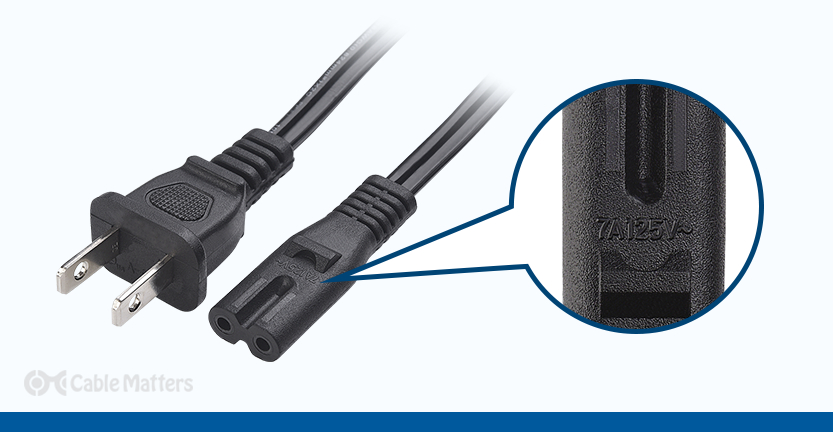
Cable Matters offers a wide range of power connectors, with all sorts of connectors, lengths, and wire gauges. If there’s something you’re looking for that you don’t see in our power cord collection, get in touch with one of our sales representatives and we’ll see if we can source what you’re after.
Conclusion
Picking the right power cable for the job is important, although it’s not a process that’s likely to trip you up. If you buy a power cable that’s the right size and shape and was produced by a quality manufacturer you shouldn’t have to worry too much about wire gauge or construction materials. Just get one that’s the right length for what you need, and you should be good to go.